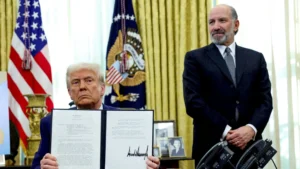Capitalizing on Market Volatility and Order Flow Amid New Tariffs
As the United States approaches April 2, designated by President Donald Trump as “Liberation Day,” the nation stands on the precipice of significant economic transformation. The administration’s plan to implement extensive tariffs aims to recalibrate trade balances and bolster domestic industries. However, this strategy carries a spectrum of anticipated effects across various sectors, from consumer goods to manufacturing, and extends its influence into the global economic arena. For those engaged in trading volatility and order flow, this economic backdrop presents both challenges and opportunities.
Impact on Consumer Prices
The imposition of tariffs is poised to directly affect consumer prices, particularly in essential categories such as food and automobiles. For instance, the average cost of 3 pounds of frozen beef, currently at $26.67, could rise to $27.76 under a 10% tariff on all goods, with even steeper increases if higher tariffs are applied to specific imports. Such price escalations are expected to strain household budgets, especially for families already navigating financial constraints. (The Independent)
Manufacturing Sector Challenges
The manufacturing landscape is experiencing heightened uncertainty. The Institute for Supply Management’s manufacturing PMI declined to 49.0 in March, indicating contraction after a brief period of growth. Factors contributing to this downturn include decreased new orders, reduced factory production, and increased input costs due to tariffs on materials like steel and aluminum. These challenges have led to job reductions within the sector, with expectations of further employment declines as the full impact of tariffs unfolds. (U.S. News and World Report)
Market Volatility and Investor Sentiment
Financial markets have responded with notable volatility. The S&P 500 entered a technical correction in March, largely attributed to apprehensions surrounding the impending tariffs. Investors are bracing for potential inflationary pressures, diminished corporate profits, and decelerated economic growth. Sectors such as technology and automotive have experienced significant stock fluctuations, reflecting broader market trepidation.
Labor Market Implications
The labor market is showing signs of strain, with job openings decreasing by 194,000 to 7.568 million in February. This reduction is largely attributed to the economic uncertainty spurred by the new tariffs. Economists express concern that these trade policies may lead to further layoffs and a slowdown in hiring, potentially elevating unemployment rates in the near term. (Reuters)
Global Trade Relations and Economic Outlook
Internationally, the tariffs have elicited apprehension among trading partners, raising the specter of retaliatory measures and escalating trade tensions. This climate of uncertainty has prompted financial institutions to adjust economic forecasts downward. Goldman Sachs, for example, has increased the probability of a U.S. recession to 35% within the next year, citing the administration’s trade policies as a significant factor. (Wall Street Journal)
Why This “Bad News” is Good News for Traders
While these developments spell trouble for consumers and long-term investors, they open a window of opportunity for traders who specialize in trading volatility and order flow. Market uncertainty fuels short-term price swings, volume surges, and institutional repositioning—all of which can be profitably exploited by nimble traders.
Traders using strategies such as Volatility Band Trading, 2SD Opening Gap plays, and order flow analysis can benefit from the chaos that shakes long-term portfolios. To improve your ability to profit from these conditions, check out our Volatility Band Trading Plan, or dive into the 2SD Gap Strategy.
These turbulent markets are also ideal for those enrolled in the Income Trading Boot Camp, which trains traders to harness trading volatility and order flow with institutional-grade tactics.
Conclusion
As “Liberation Day” approaches, the anticipated tariffs are set to usher in a period of economic recalibration. While the administration aims to strengthen domestic industries and address trade imbalances, the immediate and medium-term effects suggest a complex landscape. Consumers may face higher prices, industries could grapple with increased costs and supply chain disruptions, and the broader economy may experience heightened volatility.
However, in active trading, these conditions highlight the importance of mastering trading volatility and order flow. Traders equipped with the right strategies, tools, and mindset may find that the greatest potential for profit lies in market turmoil.
Good Trading,
Adrian Manz

